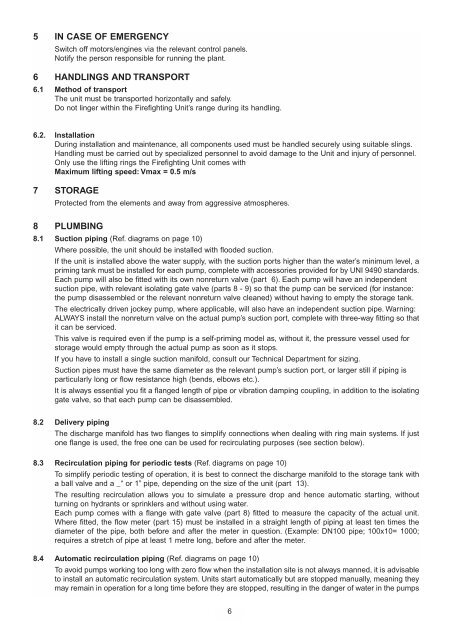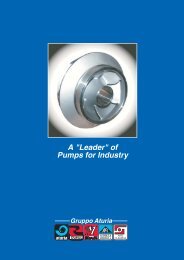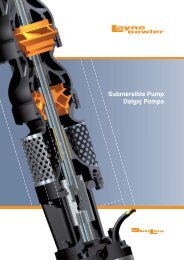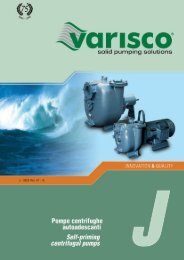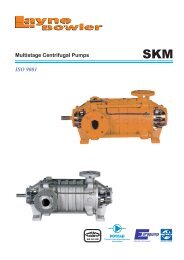UNI 9490 FIREFIGHTING UNITS - Praktikpump.sk
UNI 9490 FIREFIGHTING UNITS - Praktikpump.sk
UNI 9490 FIREFIGHTING UNITS - Praktikpump.sk
- No tags were found...
Create successful ePaper yourself
Turn your PDF publications into a flip-book with our unique Google optimized e-Paper software.
5 IN CASE OF EMERGENCY<br />
Switch off motors/engines via the relevant control panels.<br />
Notify the person responsible for running the plant.<br />
6 HANDLINGS AND TRANSPORT<br />
6.1 Method of transport<br />
The unit must be transported horizontally and safely.<br />
Do not linger within the Firefighting Unit’s range during its handling.<br />
6.2. Installation<br />
During installation and maintenance, all components used must be handled securely using suitable slings.<br />
Handling must be carried out by specialized personnel to avoid damage to the Unit and injury of personnel.<br />
Only use the lifting rings the Firefighting Unit comes with<br />
Maximum lifting speed: Vmax = 0.5 m/s<br />
7 STORAGE<br />
Protected from the elements and away from aggressive atmospheres.<br />
8 PLUMBING<br />
8.1 Suction piping (Ref. diagrams on page 10)<br />
Where possible, the unit should be installed with flooded suction.<br />
If the unit is installed above the water supply, with the suction ports higher than the water’s minimum level, a<br />
priming tank must be installed for each pump, complete with accessories provided for by <strong>UNI</strong> <strong>9490</strong> standards.<br />
Each pump will also be fitted with its own nonreturn valve (part 6). Each pump will have an independent<br />
suction pipe, with relevant isolating gate valve (parts 8 - 9) so that the pump can be serviced (for instance:<br />
the pump disassembled or the relevant nonreturn valve cleaned) without having to empty the storage tank.<br />
The electrically driven jockey pump, where applicable, will also have an independent suction pipe. Warning:<br />
ALWAYS install the nonreturn valve on the actual pump’s suction port, complete with three-way fitting so that<br />
it can be serviced.<br />
This valve is required even if the pump is a self-priming model as, without it, the pressure vessel used for<br />
storage would empty through the actual pump as soon as it stops.<br />
If you have to install a single suction manifold, consult our Technical Department for sizing.<br />
Suction pipes must have the same diameter as the relevant pump’s suction port, or larger still if piping is<br />
particularly long or flow resistance high (bends, elbows etc.).<br />
It is always essential you fit a flanged length of pipe or vibration damping coupling, in addition to the isolating<br />
gate valve, so that each pump can be disassembled.<br />
8.2 Delivery piping<br />
The discharge manifold has two flanges to simplify connections when dealing with ring main systems. If just<br />
one flange is used, the free one can be used for recirculating purposes (see section below).<br />
8.3 Recirculation piping for periodic tests (Ref. diagrams on page 10)<br />
To simplify periodic testing of operation, it is best to connect the discharge manifold to the storage tank with<br />
a ball valve and a _“ or 1” pipe, depending on the size of the unit (part 13).<br />
The resulting recirculation allows you to simulate a pressure drop and hence automatic starting, without<br />
turning on hydrants or sprinklers and without using water.<br />
Each pump comes with a flange with gate valve (part 8) fitted to measure the capacity of the actual unit.<br />
Where fitted, the flow meter (part 15) must be installed in a straight length of piping at least ten times the<br />
diameter of the pipe, both before and after the meter in question. (Example: DN100 pipe; 100x10= 1000;<br />
requires a stretch of pipe at least 1 metre long, before and after the meter.<br />
8.4 Automatic recirculation piping (Ref. diagrams on page 10)<br />
To avoid pumps working too long with zero flow when the installation site is not always manned, it is advisable<br />
to install an automatic recirculation system. Units start automatically but are stopped manually, meaning they<br />
may remain in operation for a long time before they are stopped, resulting in the danger of water in the pumps<br />
6


